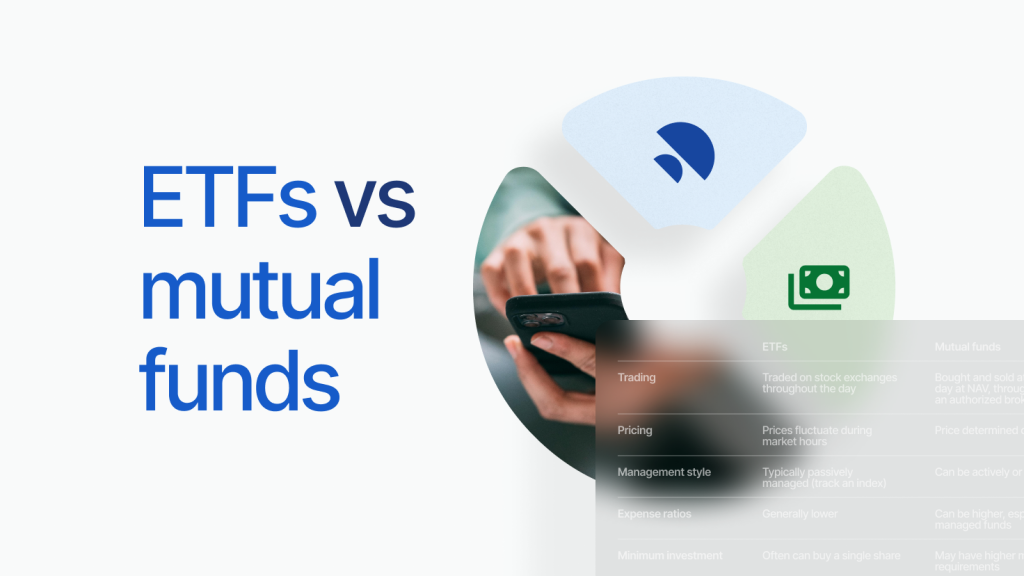Investing can feel like navigating a maze with countless options and paths. Among the most popular choices are Exchange-Traded Funds (ETFs) and mutual funds.
Both offer a way to diversify your portfolio, but they come with distinct features, benefits, and drawbacks. In this guide, we’ll break down the difference between ETFs and mutual funds for beginners, explore their pros and cons, and help you decide which might be the better fit for your financial goals and investment strategy.
What are ETFs and mutual funds?
ETFs are a basket of different investments, such as stocks or bonds, all packed into one. Imagine you want to buy a little piece of a bunch of different companies without picking each one individually. That’s what an ETF does for you.
ETFs follow the performance of a specific market index or sector, meaning they mirror the composition of the index they track. If the index goes up, so does the value of your ETF, and vice versa. These funds are typically unmanaged, meaning they do not have active managers making investment decisions. You can buy and sell ETFs on stock exchanges throughout the day, just like individual company stocks, offering flexibility and real-time pricing.
Mutual funds are similar in that they also allow you to invest in a mix of assets, but they work a bit differently. Instead of being traded on the stock exchange like ETFs, you buy mutual fund shares directly from the fund company. The mutual fund pools money from many investors to buy a diversified portfolio of stocks, bonds, or other securities.
A professional manager handles all the buying and selling of investments within the fund. The price you pay for a share in a mutual fund is determined once a day at the end of the trading day, based on the total value of all the assets in the fund, known as the Net Asset Value (NAV). This means you can’t trade mutual funds throughout the day like you can with ETFs.
Difference between ETFs and mutual funds
The key differences will help you understand the benefits of ETFs vs. mutual funds so that you can make informed investment decisions.
Feature
ETFs
Mutual funds
Trading
Traded on stock exchanges throughout the day
Bought and sold at the end of the trading day at NAV, through the fund company or an authorized broker
Pricing
Prices fluctuate during market hours
Price determined once daily based on NAV
Management style
Typically passively managed (track an index)
Can be actively or passively managed
Expense ratios
Generally lower
Can be higher, especially for actively managed funds
Minimum investment
Often can buy a single share
May have higher minimum investment requirements
Tax efficiency
Typically more tax-efficient
Less tax-efficient due to frequent capital gains
Liquidity
High, with real-time trading
Limited to end-of-day transactions
Management fees
Lower due to passive management
Higher due to active management and operating costs
Access to investments
Immediate, as they trade like stocks
Access at NAV, calculated once per day
Transparency
Holdings often disclosed daily
Holdings disclosed quarterly
Investment strategy
Best for tracking specific indexes or sectors
Suitable for various strategies, including active management
ETFs vs. mutual funds pros and cons
ETFs pros:
- Liquidity: Easy to buy and sell throughout the trading day.
- Lower costs: Generally lower expense ratios and fewer hidden fees.
- Tax efficiency: Potentially lower capital gains taxes.
- Transparency: Holdings are usually disclosed daily.
ETFs cons:
- Brokerage fees: May incur trading fees, especially if traded frequently.
- Limited customization: The holdings in an ETF are determined by the index it tracks, offering less flexibility in choosing specific investments.
Mutual funds pros:
- Market responsiveness: Actively managed mutual funds can adjust their holdings in response to market changes and opportunities.
- Access to specialized strategies: Mutual funds often offer access to niche investment strategies, such as sector-specific or multi-asset funds, which may not be as readily available in ETFs.
Mutual funds cons:
- Higher costs: Expense ratios can be higher, particularly for actively managed funds.
- Minimum investments: Often require a significant initial investment.
- Limited trading flexibility: Only trade once a day at the NAV.
How to choose between ETFs and mutual funds
When deciding between ETFs and mutual funds, consider the following:
1. Investment goals. If you’re looking for long-term growth with minimal involvement, ETFs might be the way to go. They offer passive investment opportunities and are typically more cost-effective.
2. Cost considerations. Compare the expense ratios, trading fees, and potential tax implications. ETFs often have lower costs but may involve brokerage fees.
3. Flexibility. If you want the ability to trade throughout the day or require more control over your investments, ETFs offer greater flexibility.
4. Management style preference. Decide if you prefer a passive approach, where the investment simply tracks an index, or an active approach, where professional managers try to outperform the market.
5. Tax efficiency. For those in higher tax brackets, the tax efficiency of ETFs may be a significant advantage.
Mutual funds vs. ETFs tax efficiency*
When it comes to taxes, it is assumed that ETFs are generally more efficient than mutual funds. Here’s why:
ETFs:
- “In-kind” creation and redemption process: This is a key feature that gives ETFs their tax efficiency. When investors buy or sell ETF shares, the transactions may involve an “in-kind” exchange, where the ETF issuer swaps the underlying securities with the buyer or seller without actually selling the securities. This process doesn’t trigger a taxable event, meaning the ETF doesn’t realize capital gains that would need to be distributed to all shareholders.
- Lower capital gains distributions: Because of this in-kind mechanism, ETFs avoid distributing capital gains to shareholders, which means investors are less likely to face unexpected tax bills.
Mutual funds:
- Capital gains distributions: In contrast, mutual funds frequently buy and sell securities within the fund’s portfolio. When the fund realizes a profit from selling securities, it generates capital gains. These gains are then distributed to investors, who must pay taxes on them, even if they haven’t sold any of their mutual fund shares.
- Active management: Actively managed mutual funds are particularly prone to generating capital gains, as managers frequently adjust the portfolio to meet investment objectives. This can lead to higher capital gains distributions and, consequently, a greater tax burden for investors.
*This section is for informational purposes only and does not constitute tax advice. Investing in ETFs and mutual funds involves various tax considerations that can affect the overall return on investment. It is crucial to consult with a tax professional to understand the specific tax implications of your investment choices and to ensure compliance with applicable tax laws.
ETFs vs. mutual funds for long-term investment: Returns, risk, and cost considerations
Cost considerations are a key factor when choosing between these two investment vehicles. ETFs generally come out ahead in terms of expense ratios, largely because they are passively managed. This means less management and operational expenses, allowing more of your money to stay invested. This cost-efficiency is especially beneficial for long-term investors, as the savings can compound over time, enhancing overall returns.
On the other hand, mutual funds, especially actively managed ones, often carry higher fees. These funds charge for the expertise of professional managers who actively select investments in an attempt to outperform the market. While this strategy can sometimes lead to higher returns, the associated costs can significantly reduce net gains, making them less cost-effective compared to ETFs for long-term investors.
When comparing mutual funds vs. ETFs returns, it is essential to consider the nature of the funds. Historically, actively managed mutual funds aim to outperform the market, though not all succeed. In contrast, ETFs, being passively managed, typically match the performance of their underlying index. This results in more predictable returns, although these returns may not surpass the broader market.
ETFs vs. mutual funds risk is another crucial factor to consider. Both types of investments carry inherent risks, including market risk, liquidity risk, and management risk. While ETFs often benefit from diversification and passive management, reducing certain risks, they can still be susceptible to market fluctuations and liquidity issues, especially in less commonly traded funds. Mutual funds also carry market risk, and the active management involved can introduce additional risks depending on the fund manager’s decisions.
ETFs vs. mutual funds liquidity is an important consideration for investors. ETFs offer high liquidity, as they can be bought and sold throughout the trading day, similar to individual stocks. This flexibility is advantageous for investors who may need to access their funds quickly. In contrast, mutual funds are typically only transacted at the end of the trading day at the fund’s net asset value (NAV), which may limit flexibility in accessing funds.
When investing in ETFs vs. mutual funds, investors must weigh the factors of returns, risk, expense ratios, and liquidity. ETFs generally offer lower costs and predictable returns but with potential liquidity and market risks. Mutual funds provide access to professional management and a broader range of strategies but may come with higher costs and risks depending on the fund’s management style.
ETFs vs. mutual funds in 2025
Both ETFs and mutual funds continue to evolve. The ETF market is expanding rapidly, with more options available than ever before, including thematic ETFs and ETFs focusing on specific sectors or trends.
Mutual funds are also innovating, with more funds offering lower fees and greater transparency. The choice between ETFs and mutual fundswill likely depend on the same core factors: cost, investment goals, and management style.
Investing in ETFs vs. mutual funds: The bottom line
Both ETFs and mutual funds offer valuable opportunities for investors. ETFs provide low-cost, diversified access to a wide range of assets and are highly flexible, making them a great choice for cost-conscious investors. Mutual funds offer professional management and a variety of investment strategies, making them suitable for investors looking for a more hands-off approach.
Choosing between ETFs and mutual funds ultimately depends on your investment goals, risk tolerance, and preferences. Both investment vehicles offer unique benefits and potential drawbacks. By understanding the key differences and evaluating your personal financial situation, you can make a more informed decision and build a portfolio that aligns with your financial goals.
At Mintos, we provide an ETF portfolio management service that might align with your investment needs, offering a straightforward and efficient way to diversify your portfolio. Whether you’re looking for long-term investments, passive income ideas, or risk diversification, investing with Mintos Core ETF could be a valuable addition to your investment strategy. Remember, investing wisely involves understanding your options and making informed decisions.
Disclaimer:
This is a marketing communication and in no way should be viewed as investment research, investment advice, or recommendation to invest. The value of your investment can go up as well as down. Past performance of financial instruments does not guarantee future returns. Investing in financial instruments involves risk; before investing, consider your knowledge, experience, financial situation, and investment objectives.

